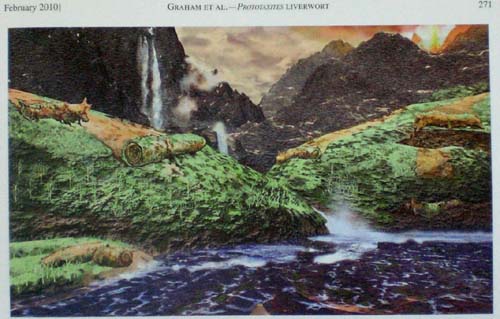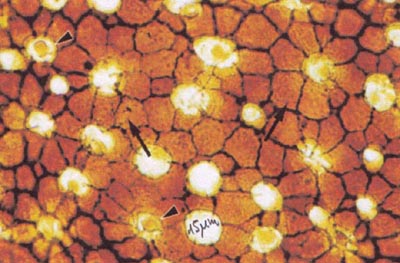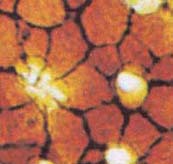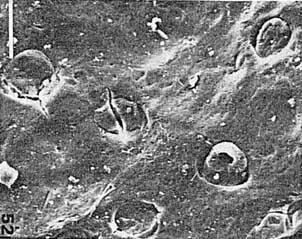Prototaxites
and Cosmochlaina:
no liverwort connection
A very peculiar hypothesis has been presented [1] as an explanation for
the big enigmatic fossil called Prototaxites.
This fossil has been
included into the chapter Enigmatic Organisms in [2] since it looks
like a tree trunk but does not consist of wood, and it lived in the
Silurian and Lower Devonian when plants on land did not exceed heights
of a few
centimeters.

In order to obtain, in imagination, a big trunk-like
fossil from the humble vegetation, the authors [1] invoke the idea of
rolled-up mats. Liverwort mats on sloping rock surfaces are supposed to
curl in at the upper end and eventually start rolling down the slope as
pictured with artistic skill in Fig.1. Leaving aside the question how
all those carpet rolls could become so tightly wound that their
cross-sections remained nearly circular while lying around awaiting
silicification, one can challenge the hypothesis by starting from
the liverwort side of the problem. Small nematophytes recently found in the Rhynie chert
provide surprising insights.
Fig.1: Prototaxites
forming from liverwort rolls
as imagined by GRAHAM
et al. (2010) [1].
Fossil liverworts are known since the Upper
Middle Devonian [2]. In
order to have liverworts in the Silurian, the authors [1] had
re-interpreted Silurian cuticles known as Nematothallus
and
Cosmochlaina
(Fig.2), usually thought to belong to the nematophytes,
as
liverwort cuticles in a previous publication [3]. Recent finds of
nematophytes in Rhynie
chert provide contrary evidence [4]. A concise
version of the presentation [4], focused on the explanation of the
hitherto unexplained structure of the Nematothallus
cuticle, is given in Rhynie
Chert News 38.
What remains to be done is to interpret the conspicuous pattern of Cosmochlaina
without resorting to liverworts. (According to [1], the arrows in Fig.2
indicate "pores surrounded by cell rosettes", which is shown to be a
misinterpretation in the following.)
Fig.2 (below) with detail:
Silurian cuticle Cosmochlaina,
re-interpreted in [1] as lower epidermis
tissue of liverworts with broken-off rhizoids but quite differently
interpreted here.


The
rather superficial similarity to the lower epidermis of liverworts with
broken-off rhizoids misled Graham
et al. [3] to the assumption that it
really is such. The polygonal meshes, cautiously called "entities" in
[5] but readily interpreted as cells in [3], should better give rise to
suspicion. Rhizoids grow from one cell each so that a rhizoid emerging
from 7 cells at once as in this picture (see detail) would
not
make sense. By carefully inspecting Fig.2 one finds more features of
the pattern which are hardly compatible with the notion of a cell
sheet. Here it is useful to know that what looks like a cellular
pattern could be a crack pattern, an idea which may suddenly remove
apparent absurdities and open other vistas. (For another case
of this
type, see Rhynie
Chert News 8.)
According to the
interpretation proposed here, Cosmochlaina
is a cuticle belonging to a
nematophyte as originally assumed. The round spots are the
cross-sections or ends of the tube-like filaments embedded in gel which
make up
the nematophyte. Hence, the old problem of how a nematophyte could
produce a cell sheet has vanished: There are no cells but only cracks.
The cracks could be due to shrinkage of the drying surface of the lump
of gel. The nematophyte could have released an organic substance which
accumulated on the gel surface, polymerized into a decay-resistent
cuticle as a protection against exsiccation, and thus preserved a
replica of the surface crack pattern.
Unexpectedly, an early paper on
Cosmochlaina
[5] supports the interpretation of Fig.2 as a crack pattern. There,
specimens are shown whose aspect differs much
from Fig.2, the most often reproduced picture of this fossil: See Fig.3.

Fig.3 (right): Cosmochlaina
as it is seldom pictured [5]: no polygon pattern
but early stage of crack propagation.
Remarkable is the absence of the polygon pattern
which is often thought to be an inherent feature of
Cosmochlaina
but is not.
Apparently the cuticle in Fig.3 shows a very
early stage of crack pattern formation, with only a few short cracks
emerging from the tube cross-sections. The transition from individual
cracks to polygon patterns is not yet completely understood in fracture
mechanics but the
phenomenon as such is well known from various substances undergoing
shrinkage.
Annotation 2020: A
tendency of growing shrinkage cracks to form polygon patterns has been
demonstrated with fracture mechanical computations in [7].
Now that no evidence is left for Silurian liverworts in the disguise of
Cosmochlaina
and Nematothallus,
the liverwort hypothesis of
Prototaxites
lacks its main ingredient. Without any other vegetation
available for making carpet rolls from, Prototaxites
remains as
enigmatic as ever. (See also [6].)
H.-J. Weiss
2010 2020
[1] L.E.
Graham,
M.E. Cook, D.T. Hanson, K.B. Pigg, J.M. Graham :
Structural, physiological, and
stable carbon isotope
evidence that the enigmatic Paleozoic fossil Prototaxites formed
from
rolled liverwort mats.
Am. J. Bot.
97(2010), 268-275.
[2] T.N. Taylor,
E.L. Taylor, M. Krings : Paleobotany, Elsevier 2009,
p163.
[3] L.E. Graham,
L.W. Wilcox, M.E. Cook, P.G. Gensel
:
Resistant tissues of
modern marchantoid liverworts resemble enigmatic Early Paleozoic
microfossils.
Proc. Nat. Acad.
Sci., USA, 101(2004), 11025-29.
[4] H.-J. Weiss:
Nematothallus: How the filaments produced a cellular
cuticle. (Oral presentation)
8th European
Palaeobotany - Palynology Conference 2010, Budapest.
[5] D. Edwards :
Dispersed cuticles of putative non-vascular plants from
the Lower Devonian of Britain,
Bot. J. Linnean Soc.
93(1986), 259-75.
[6] H. Steur:
www.xs4all.nl/~steurh/
[7] M. Hofmann, R. Andersson, H.-A. Bahr, H.-J. Weiss, J. Nellesen: Why
Hexagonal Basalt Columns?
Phys.
Rev. Lett. 115, 154301 (2015)
 |
 |
41 |







